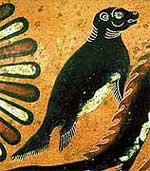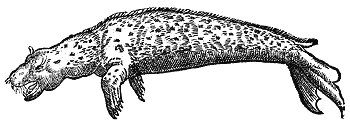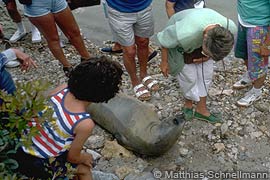

 |
||
 |
||
Vol. 8 (1): May 2005 |
Download this article
|
|
IN ECHOES OF THE PAST,
|
 |
|
|
A kinder place: the monk seal in ancient Greek myth, depicted on a water jug, some 2,500 years old. |
The seal played a distinct role in Mediterranean myths and superstitions. Animistic imaginations transformed the creatures into nymphs and mermaids. In Greek mythology, they were placed under the protection of Poseidon and Apollo (Johnson & Lavigne 1999a).
And yet aside from such benign traditions, history shows that the human relationship with monachus has always been starkly utilitarian.
Although there are some notable exceptions, by and large this relationship was governed by the species’ perceived value in fur, oil, and meat, its efficacy in medicine and magical rites, its public appeal in circuses and zoos. The benefits, real or imagined, were legion. The fur of the seal could predict storms and tempests, while mother’s milk found in the stomach of pups was reputed to cure epilepsy and other diseases. The right flipper, placed under the pillow, would ward off insomnia, while the whiskers, distilled into a potion, could win friends and lovers or drive off enemies. Some explorers won small fortunes by boiling seals into oil, and even the poorest fisherman or farmer might benefit by turning the animals into shoes or harness leather.
For the most part, then, monk seals have always been worth far more dead than alive.
Even for zoos and menageries – which presumably had a vested interest in keeping their captives alive for as long as possible – monk seals were obviously worth far more out of their element than along the coasts of their birth. The showman’s ‘talking fish’ may have had a limited shelf life as it was carted around Europe in appalling conditions, but still it generated more than enough gold and silver coin to enrich its owner and pay for its own replacement.
Even when counting costs rather than profits, attitudes towards the species tended to be essentially utilitarian in nature – the seal branded as a pest that threatens fish stocks and damages fishing nets, for example. Such hostility was probably responsible for transmuting the mermaid seal into the sea devil in the folklore in the Dark Ages, and also inspired the myth that the seal would hunt down fishermen in vicious, tooth-gnashing, packs.
 |
|
|
A Renaissance woodcut of a Mediterranean monk seal, from Guillaume Rondelet, 1554. |
Even conservation of the species has rarely risen above the prevailing utilitarian tide.
In the 19th century, hunters noticed the decline of the species and appealed for its preservation – if only to allow other specimens to be peppered with shot.
A century later, international charities and scientific institutions were voicing concern about the plummeting fortunes of the seal, yet largely inspired by the same utilitarian reasoning. Monk seals had to prove their value and usefulness to human beings in order to be deemed worthy of survival. A report to the International Union for the Conservation of Nature (IUCN)[1] in 1962, for example, advocated the following measure to halt the continuing decline of the species: “To point out to governments that Monk Seals are an important but now only a potential natural resource. Managed properly the seal could become a permanent source of skins, meat and oil” (Wijngaarden, 1962).
More recently, scientists have pondered whether the monk seal might, if protected, regain some of its legendary tameness, thereby becoming a potential attraction for the tourist industry, whose current brutal indifference is largely responsible for shunting the species into an early grave. Others have suggested that fishermen might be persuaded to relinquish their traditional hostility towards the seal by ferrying paying tourists into marine protected areas (Sergeant et al., 1979; Johnson & Lavigne, 1999b).
 |
|
|
With international NGOs and governments consistently failing to commit to the species, will monk seals become a lucrative attraction for the tourist industry? |
While the logic of bringing such protagonists into the conservation process may be unassailable from a pragmatic standpoint, it does little to alter the fact that, fundamentally, utilitarian attitudes towards the species remain intact.
Even passive arguments tend to reflect the same utilitarian and anthropocentric values, the disappearance of the species, for example, being lamented as a loss to human heritage. In much the same vein, research that is often invasive is justified on the basis that it will benefit science. Few words are ever spoken, it seems, of the monk seal’s intrinsic value, irrespective of human self-interest.
The apparent reluctance of the international conservation community to address, consistently and comprehensively, the dwindling fortunes of the monk seal may eventually prove attributable to the same factors.
Shunned by most multinational conservation charities, it appears that the Mediterranean monk seal – despite the dubious privilege of being elected Europe’s most endangered marine mammal – has yet to prove itself capable of rivalling the financial clout, public recognition and press coverage of, say, the giant panda, the African elephant or the harp seal.
While many myths are rooted in utilitarian values, on occasion, the inverse may be equally true.
For coastal fishermen, for example, the seal continues to be a scapegoat for ‘their’ diminishing fish stocks, even as industrial trawlers plunder the sea a figurative stone’s throw from their own boats.
Or consider the comforting myth – so reminiscent of a more ancient one, “Rome has spoken; the matter is settled!” – that legislation outlawing the killing of monk seals has actually had a measurable effect in stemming the decline of the species. Indeed, with remote, tortuous coastlines and lack of enforcement, direct killing has consistently remained the most serious mortality factor affecting monachus in the eastern Mediterranean (Androukaki et al. 1999).
Likewise, international conference resolutions, treaties and conventions, action plans endorsed by governments and scientists, often conjure up the myth that conservation of Monachus monachus is a coherent, tangible force with assured funding, established targets and regular audits of results. Such is not the case, however, and has little prospect of becoming so in the foreseeable future.
The reality on the ground is that, even a quarter century after the landmark Rhodes international conference drew up a raft of measures to rescue the species from impending oblivion, and despite the single-minded efforts of grassroots organisations in pursuing those objectives, the monk seal continues to be betrayed by official indifference (Ronald & Duguy 1979). Twenty-five years after the event, in fact, governments have yet to establish even one fully-functioning marine protected area for the species in the Mediterranean basin, let alone the interconnecting network of reserves envisaged at Rhodes.
Arguably, it is only through the reading of history that we can begin to understand why the seal of the Mediterranean sea is so perilously close to extinction.
Androukaki, E., S. Adamantopoulou, P. Dendrinos, E. Tounta and S. Kotomatas. 1999. Causes of Mortality in the Mediterranean Monk Seal (Monachus monachus) in Greece. Contributions to the Zoology & Ecology of the Eastern Mediterranean Region 1 (1999): 405-411.
Johnson, W.M. and D.M. Lavigne (a). 1999. Monk seals in antiquity. The Mediterranean monk seal (Monachus monachus) in ancient history and literature. Mededelingen 35: 1-101. The Netherlands Commission for International Nature Protection, Leiden: 1-128, 17 figs. [Abstract]
Johnson, W.M. and D.M. Lavigne (b). 1999. Mass tourism and the Mediterranean monk seal. The role of mass tourism in the decline and possible future extinction of Europe's most endangered marine mammal, Monachus monachus, The Monachus Guardian 2 (2): 1999. [PDF ![]() 465KB]
465KB]
Ronald, K., and R. Duguy. (eds). 1979. The Mediterranean Monk Seal. First International Conference on the Mediterranean Monk Seal. 2-5 May 1978, Rhodes, Greece. Pergamon Press, Oxford, UK. 1-183.
Sergeant, D., K. Ronald, J. Boulva, and F. Berkes. 1979. The Recent Status of Monachus monachus, the Mediterranean Monk Seal. In: K. Ronald and R. Duguy, eds. The Mediterranean Monk Seal. First International Conference on the Mediterranean Monk Seal. 2-5 May 1978, Rhodes, Greece. Pergamon Press, Oxford, UK: 1-183.
Wijngaarden, A. van. 1962. The Mediterranean Monk Seal. From a Report to the International Union for Conservation of Nature. Oryx. Fauna & Flora Preservation Society, London 6: 270-273.
|
This article has been adapted from William M. Johnson’s 2004 publication: Monk seals in post-classical history. The role of the Mediterranean monk seal (Monachus monachus) in European history and culture, from the fall of Rome to the 20th century. Mededelingen 39. Netherlands Commission for International Nature Protection, Leiden: 1-91, 31 figs. [Abstract] For ordering information, please contact:Backhuys Publishers, Warmonderweg 80, NL-2341 KZ Leiden, The Netherlands. Retail Price: € 18.- |
[1] Now also known as the World Conservation Union.
Copyright © 2005 William M. Johnson, The Monachus Guardian. All Rights Reserved |